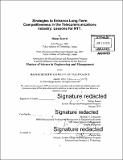Strategies to enhance long-term competitiveness in the telecommunications industry : lessons for NTT
Author(s)
Kawai, Shingo, S.M. Massachusetts Institute of Technology
DownloadFull printable version (8.610Mb)
Other Contributors
System Design and Management Program.
Advisor
Michael A. Cusumano.
Terms of use
Metadata
Show full item recordAbstract
In the telecommunications industry, the market is highly global as well as competitive in this era of Internet and data communications. Telecommunications carriers compete with not only other telecommunications carriers providing broadband access and mobile communication but also network application and service providers, which are significant threats for telecommunications carriers. It is difficult for telecommunications carriers to control the market for two significant reasons. Firstly, due to the maturity of technology as well as customers, network services have become commoditized. Secondly, telecommunications network services are vulnerable to over-the-top services based on the Internet. This study aims to investigate how large telecommunications carriers can continue to be competitive in such an environment. This paper focuses on three kinds of strategic options that enable large high-tech companies to continue to make profits; internal R&D, growth and diversification, and M&A. In the second chapter the author focuses on IBM and Cisco, which are good examples of how large companies have evolved over time, combining these three strategies. Then, the use of the three strategies by major telecommunications carriers is investigated. Finally, in the fourth chapter, the author analyzes the future competitiveness of the NTT Group, the major telecommunications carrier in Japan, using these strategies within the next decade.
Description
Thesis: S.M. in Engineering and Management, Massachusetts Institute of Technology, Engineering Systems Division, 2014. Cataloged from PDF version of thesis. Includes bibliographical references (pages 73-75).
Date issued
2014Department
System Design and Management Program.; Massachusetts Institute of Technology. Engineering Systems DivisionPublisher
Massachusetts Institute of Technology
Keywords
Engineering Systems Division., System Design and Management Program.